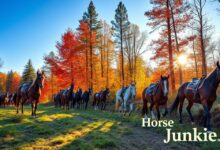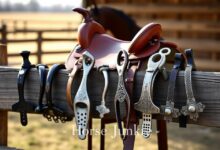Western Style Horse Riding: Explore the Adventure
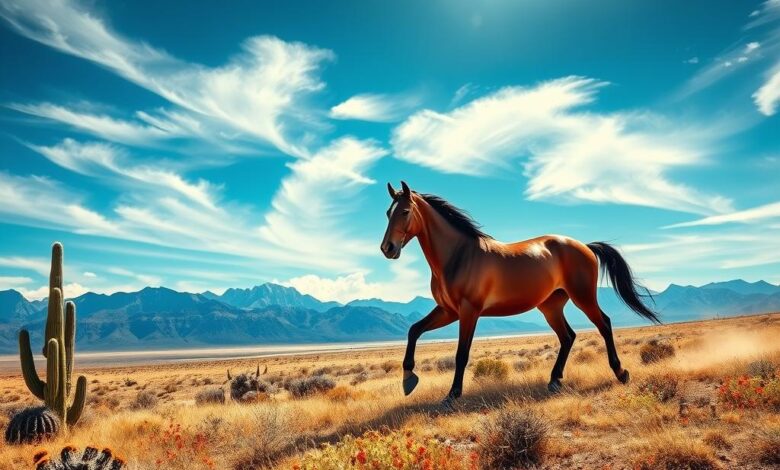
Ever wondered what it’s like to ride through the American West? Western style horse riding is more than just a way to get around. It’s an exciting adventure filled with tradition and skills from cowboy culture. We’ll dive into the heart of western riding, its iconic gear, and the fun of horseback riding lessons at our local equestrian center.
Western riding combines control, comfort, and a strong bond between horse and rider. It’s perfect for both seasoned riders and beginners looking to start. This journey will spark your passion and make you appreciate the art of riding even more.
Key Takeaways
- Western style horse riding offers a unique connection with the cowboy spirit.
- Riding adventures are available ranging from single riders to groups of 12.
- Costs vary widely, from $525 for a night to $4,069 for an extended riding journey.
- Participants of varying skill levels can join horseback riding lessons.
- A Western saddle is designed for comfort during long rides, making it distinct from English riding.
- The challenges of varied terrains enhance the riding experience, offering both thrill and skill development.
The Essence of Western Style Horse Riding
Western style horse riding is a unique and engaging part of the equestrian world. It combines culture, practicality, and a deep connection between rider and horse. Knowing the differences in riding styles helps us see what makes western riding special. It also highlights its key features and the many benefits of western riding.
What Sets It Apart from Other Riding Styles
Western riding is known for its relaxed posture and equipment. Unlike English riding, which focuses on precision, western riding is more laid-back. The western saddle is designed for comfort and stability, perfect for outdoor adventures.
Western riding techniques help us connect better with our horses. This leads to a more natural and intuitive riding experience.
Key Characteristics of Western Riding
Western riding has several unique features:
- The western saddle has a horn and a larger seat for comfort during long rides.
- Western riding uses split reins for better communication with the horse.
- Riders wear hats, jeans, and boots, showing off a cultural style while staying safe and comfortable.
Benefits of Adopting a Western Riding Style
Western riding brings many benefits:
- It boosts confidence as riders learn to understand their horses better.
- It improves communication skills, leading to a better connection during rides.
- It lets riders enjoy a rich cultural heritage while having fun outdoors.
Essential Gear for Western Riding
Having the right gear is key for a fun and safe ride in western riding. The right gear helps us perform better and talk better with our horse. Let’s look at the must-haves for every western rider.
Saddles: Choosing the Right One for You
When picking western saddles, think about comfort and control. Each saddle is for a specific riding style. A good fit is not just for us but also for our horse’s health. We need to think about size, design, and what we need when choosing.
Bridles and Bits: Understanding Their Function
Bridles are vital for talking to our horse while riding. They should fit the horse’s head right and stay in place. Bits and reins help us guide our horse. Knowing how to pick these tools can make our ride better.
Clothing: Dressing for Comfort and Safety
Wearing the right clothes is important in western riding. We should choose durable, comfy clothes that keep us safe. Key items include:
- Riding Boots: Long or short, they offer support and comfort.
- Riding Gloves: Prevent blisters and help us hold the reins well.
- Riding Pants: Breeches or jeans keep us safe and move freely.
- Helmets: Crucial for safety, they must meet current standards.
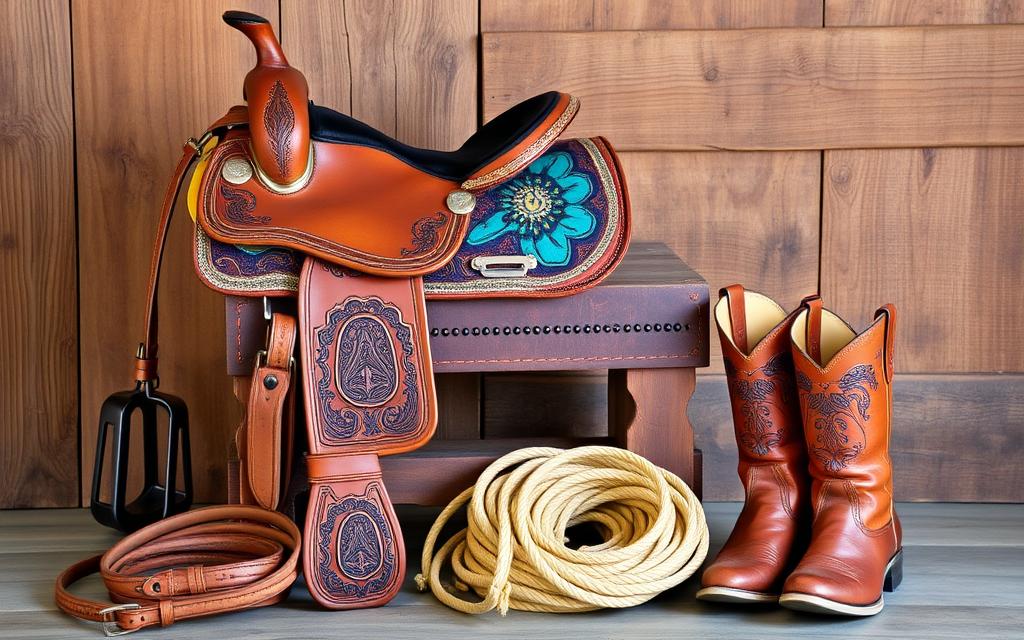
Horse Breeds Suitable for Western Riding
Looking for the right horse for western riding? We’ve found some amazing animals with special traits. Knowing the best breeds can make our western riding adventures even better.
Popular Breeds for Western Disciplines
Here are some top suitable horse breeds for western riding:
- Quarter Horse: Known for speed and agility, they’re great at barrel racing and roping.
- Appaloosa: They’re calm and have lots of stamina, making them perfect for many western activities.
- Paint Horse: With a friendly nature and versatility, they’re great for both fun rides and competitions.
- Tennessee Walking Horse: Their smooth gaits make them perfect for long, comfortable rides.
- Arabian: Famous for endurance, they’re excellent for trail riding because they’re sure-footed.
Evaluating a Horse’s Suitability
When checking if a horse is right for western disciplines, we look at a few things:
- Temperament: A calm horse is more fun to ride.
- Conformation: The horse’s body should match the needs of the western discipline.
- Previous Training: Knowing a horse’s past helps us pick the right one for us.

Choosing the right horse for western riding is key. By understanding their traits, we can enjoy our rides more. Making sure our horse fits our needs makes our time together in the saddle rewarding.
The Importance of Training in Western Riding
Effective training is key to western riding success. It helps both horse and rider grow. Groundwork training is especially important. It builds communication and respect, laying a strong foundation for our horses.
Groundwork Fundamentals
Groundwork is the first step in horse riding education. It includes lunging, round penning, and showmanship. These exercises teach us about our horse’s behavior and body language.
Building trust and respect through groundwork strengthens our bond with our horses. Regular sessions boost our confidence. They help us apply these skills when we ride.
Riding Fundamentals for Efficient Control
After groundwork, we learn riding basics for control. Training in western riding means understanding our horse’s movements. We use balance and weight shifts to communicate effectively.
Having an independent seat and relaxed posture helps us coordinate better with our horses. This connection makes our riding safer and more enjoyable in all disciplines.
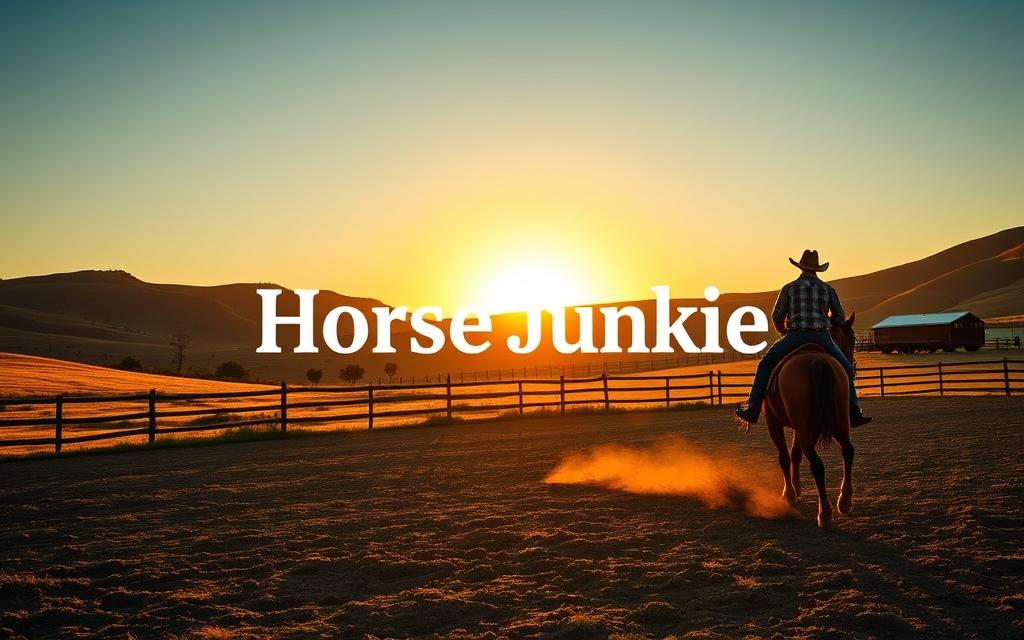
Safety First: Riding Responsibly
Keeping ourselves safe while riding is key to having fun. By wearing the right gear and riding smart, we can avoid accidents. Here are some top safety tips for horseback riding to keep us safe on our rides.
Essential Safety Gear Recommendations
Choosing the right safety gear is a big step in protecting ourselves and our horses. Important items include:
- Helmets: A hard hat is a must and should meet safety standards. We should replace helmets every five years or after a fall.
- Footwear: Good shoes with a good grip are crucial to prevent accidents while handling horses.
- Body Protectors: Older riders might want to wear body protectors for extra safety.
Checking our gear, like cinches, can prevent many accidents. Also, keeping our belongings secure is important. Objects falling from the horse ahead can be a big hazard.
Tips for Riding in Various Conditions
Changing our riding style for different weather is just as important. Here are some safety tips for horseback riding:
- Check the terrain before riding, as slippery mud can cause accidents, especially if we ride too fast.
- Stay hydrated to avoid getting too hot; most riding accidents happen because of tiredness.
- Know how our horse acts and watch our surroundings. Follow guides’ advice to keep the group together and avoid problems.
Being careful is crucial; horses can be unpredictable, and keeping a safe distance helps prevent injuries. Riding safely lets us enjoy our rides more while keeping risks low. Always put safety first for a great horseback riding experience.
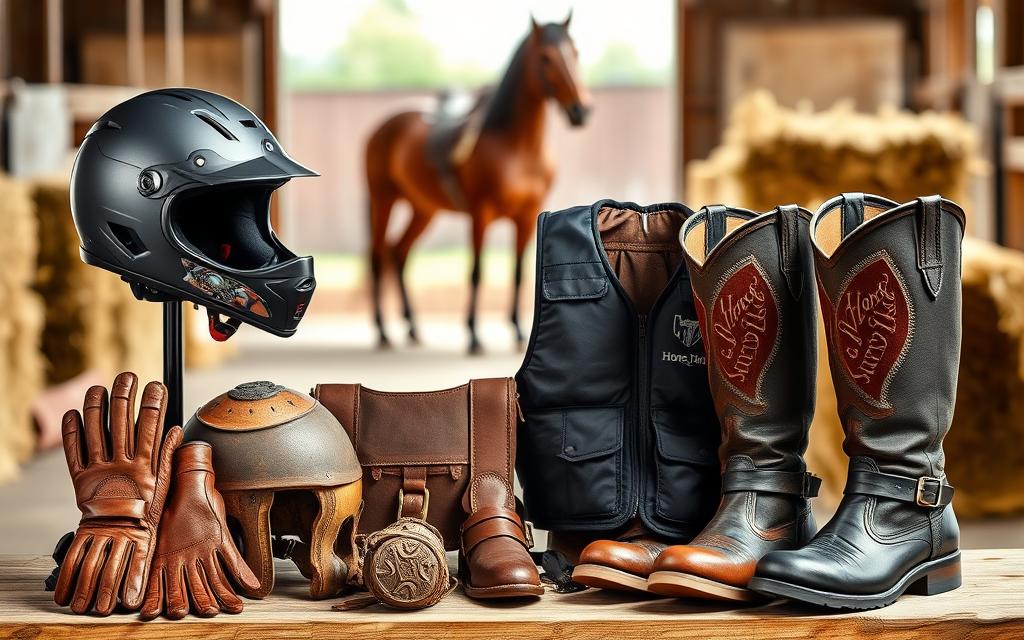
Understanding Western Riding Techniques
Learning how to ride well is key for fun and success in Western riding. It’s important to know the difference between one-handed and two-handed riding. Also, using leg cues is crucial for talking to the horse and improving our skills.
One-Handed vs. Two-Handed Riding
One-handed riding is a big part of Western riding. It’s great for fast activities like barrel racing because it lets us make quick turns. We can hold the reins with one hand and use the other for signals or whips.
Two-handed riding is mostly for beginners or when we need more control. It’s good for training because it lets us communicate directly with the horse. Knowing both methods can really help us ride better.
The Role of Leg Cues
Leg cues are vital for guiding the horse without just using the reins. They are like secret signals that tell the horse what to do. For example, a squeeze with our legs tells the horse to go, and shifting our weight helps with turns.
Learning these cues makes our riding better. It helps us connect with our horse and do different moves smoothly. This is important for a good riding experience.
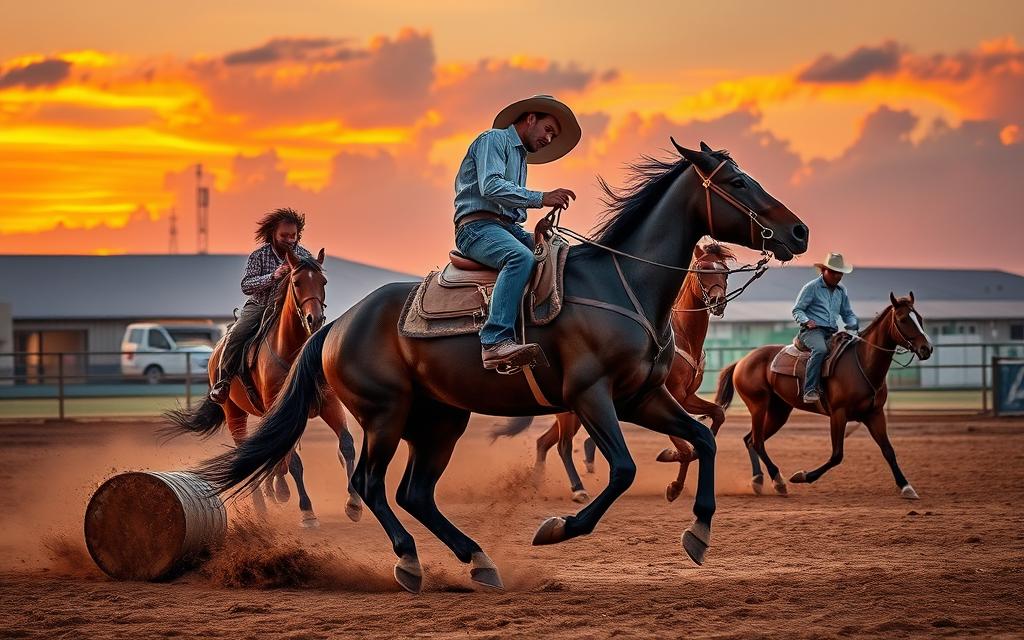
Common Western Riding Disciplines
Western riding includes many disciplines, each offering unique chances to learn and have fun. Exploring these activities helps us understand horse riding better. It also deepens our bond with our horses.
Barrel Racing: Thrilling Speed and Precision
Barrel racing is thrilling. Riders go around three barrels in a cloverleaf pattern, aiming for the fastest time. They usually take about 15 seconds per run.
The precision needed is high. All barrels must stay upright to avoid penalties. This event mainly features female riders, showing their speed and skill.
Roping: Techniques and Tools Explained
Roping is a key part of western riding. It requires specific techniques and tools. Breakaway roping is about quickly lassoing a calf, while team roping involves two riders working together to rope a steer.
Learning these skills improves our teamwork with the horse. It emphasizes agility and precision.
Trail Riding: Embracing Nature on Horseback
Trail riding lets us explore beautiful landscapes and bond with our horses. In competitive trail riding, riders face obstacles within a set time, regardless of their attire. This discipline helps us enjoy nature while improving our riding skills.

The Social Aspect of Western Riding
Being part of the western riding community makes our riding experience richer. Joining riding clubs and organizations lets us dive into a world of shared passion and friendship. These groups are great for learning and growing, where we meet others who love cowboy culture.
Joining Riding Clubs and Organizations
Being in riding clubs opens up a world of activities for all skill levels. These groups offer:
- Workshops and clinics to learn more.
- Chances to meet and learn from experienced riders and trainers.
- Fun social events to make new friends in the western riding community.
These connections help us get better at riding and love the western riding lifestyle even more.
Community Events and Competitions
Entering equestrian events shows off our skills and helps us grow. Competitions like barrel racing or rodeos let us test our abilities. These experiences:
- Help us build friendships with other riders.
- Let us learn from watching more experienced riders.
- Help us introduce new friends to western riding.
Community events also teach the public about western riding. Both new and experienced riders find ways to connect with this tradition.
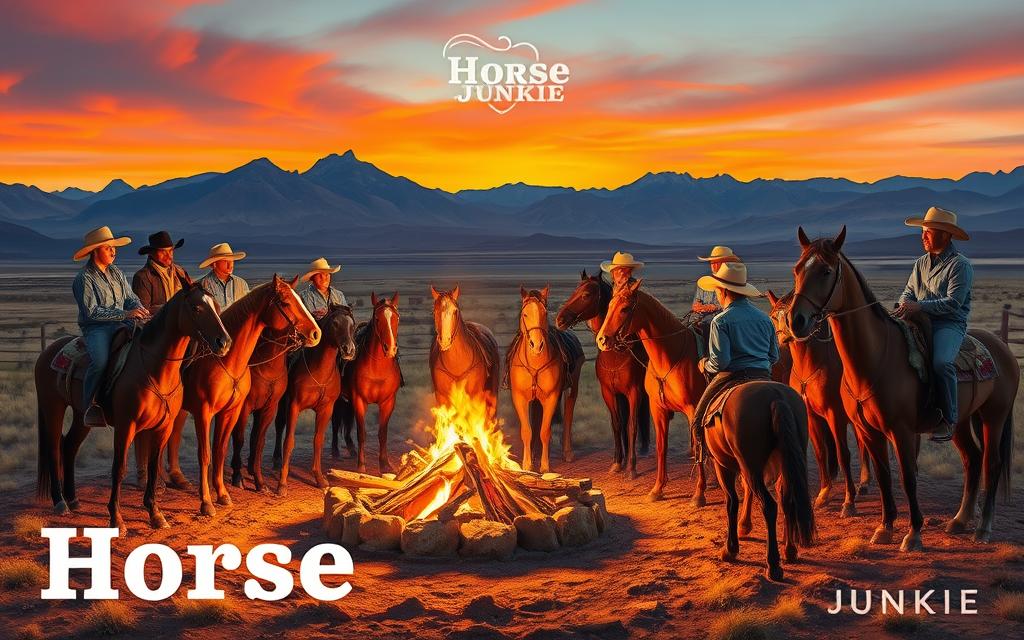
Preparing for a Ride: Pre-Riding Routine
Going on horseback rides needs careful planning for a safe and fun time. A good pre-ride routine is key to making it happen.
Health Checks for Your Horse
First, we must do a health check on our horse before we start. Look for any signs of pain, like swelling or limping. Make sure the tack fits right to avoid accidents or stress for the horse.
A quick grooming session helps strengthen our bond with the horse. It also lets us find any injuries or issues that need fixing.
Planning Your Route
Choosing the right trail is crucial for a great ride. Pick a path that matches your horse’s experience and your riding skills. Think about the trail’s condition, the weather, and if there are other riders or obstacles.
Knowing about potential dangers helps everyone have a better ride. Being prepared makes the experience enjoyable for everyone.
Caring for Your Horse
Caring for our horse means knowing what they need to stay healthy and perform well. We must focus on their nutrition and grooming to keep them fit and happy. Let’s look at the key areas of horse care we need to focus on.
Nutrition: What Our Horse Needs
Good nutrition is key for our horse’s energy and health. We should give them a balanced diet that fits their age, activity level, and breed. Here are the important nutrients to watch:
- High-quality hay: A main source of fiber for digestion.
- Grains: Help with energy, especially for active horses.
- Supplements: Fill in any nutritional gaps with vitamins and minerals.
Grooming: Best Practices for Horse Care
Grooming is crucial for our horse’s looks and health. It also builds trust and strengthens our bond. Good grooming includes:
- Brushing: Removes dirt and promotes healthy skin and coat.
- Hoof care: Keeps hooves clean to avoid problems like thrush or laminitis.
- Routine health checks: Watch for signs of illness or discomfort for early treatment.
The Joys of Riding in Nature
Western riding lets us dive into stunning landscapes. We explore nature on horseback, enjoying diverse trails. These paths take us through meadows and mountains, deepening our bond with nature.
Scenic Trails for Western Riding
Choosing scenic trails opens a world of beauty and calm. These paths wind through breathtaking views, offering a unique way to see nature. Some top trails include:
- National parks with well-maintained paths and stunning views
- Backcountry trails that offer a more off-the-beaten-path experience
- Riding through forests that envelop us in cool shade and tranquility
- Coastal routes where we can enjoy ocean breezes and sandy shores
The Experience of Riding in Different Landscapes
Every landscape we ride through brings new sensations and challenges. Riding in nature boosts our appreciation for the outdoors and our riding skills. We learn to communicate better with our horse as we tackle different terrains.
Riding in nature is more than a workout. It’s a chance for mental health, leaving us feeling happy and refreshed. As we explore, our physical and emotional sides merge, showing the beauty of harmony between riders, horses, and nature.
Continuing Education in Western Riding
The journey in western riding is always ongoing. It doesn’t end once we learn the basics. By joining clinics and workshops, we can improve our skills and learn new techniques from experts.
Going to reputable western riding clinics gives us a chance to practice and get feedback. This helps us get better and connect more with our horses.
Clinics and Workshops: Expanding Our Skills
We can also use books and online tutorials to learn more about western riding. Many programs in the United States, like those certified by the CHA, offer structured learning. These programs include practical tests and workshops to show our skills and commitment.
Resources for Improving Our Techniques
Being part of groups like the Interscholastic Equestrian Association (IEA) helps us improve our riding. IEA has many events and competitions. These opportunities help us learn, get mentorship, and meet others who love western riding.
By using these resources, we become better horse riders. Every ride becomes an exciting adventure.
FAQ
What is western style horse riding?
What equipment is essential for western riding?
What are popular horse breeds for western riding?
How important is training in western riding?
What safety precautions should we take while riding?
What techniques are unique to western riding?
What disciplines are included in western riding?
How can we engage with the western riding community?
What is a pre-riding routine, and why is it important?
How do we care for our horse to ensure its well-being?
What are some of the joys of riding in nature?
How can we continue to improve our western riding skills?
Source Links
- * Unicorn Trails * Western Style Horse Riding Holidays. . . . . . western saddle horseback vacations
- Exploring the Different Horseback Riding Disciplines: Which One is Right for You?
- Different Types of Horse Riding Styles (3 Disciplines)
- Exploring the Different Horseback Riding Disciplines: Which One is Right for You?
- Tack and Attire: English VS Western, What’s Your Pleasure?
- Western Reining – the proud western horseback riding discipline
- The Must-Have List for Anyone Who Wants to Start Horse Riding – Pine Hill Ranch
- Western Riding Bootcuts | Best Western Riding Pants
- An Expert Guide to Equestrian Attire
- Saddle Up: A Guide to Different Types of Riding Horses
- How to Choose the Right Horse Breed for Your Riding Style | Gladiator Equine
- What Horse Breed is Right For Your Riding Style?
- English vs. Western Riding: Similarities and Differences – US Whip
- Western horse riding: the art of subtle communication with a horse
- Unleashing the Benefits of Western Riding and Horsemanship for English Riders – GRASSROOTS GAZETTE
- Riding Safety Tips – Equitours – Horseback Vacations Worldwide
- Safety when Riding – In The Saddle
- 7 Western Horseback Riding Tips For Beginners – US Whip
- English or Western: Which Is the Best Riding Style for You?
- The difference between Western and English horseback riding | AGDAILY
- What are the Different Types of Western Horseback Riding? | Ariat
- 20 Different Types of Western Riding (With Video Examples) – Horse Rookie
- A Guide to Western Riding
- The Great Debate: English vs. Western Riding
- All Seasons Horse Riding | Alamo | Riding Styles
- Getting Fit: For a Horseback Riding Trip (Part 4)
- Create a Pre-Ride Routine
- So, You’re Going on a Trail Ride
- Riding tips: western versus English
- How to Tack Up for Western Riding
- The Top 15 Benefits of Horseback Riding – Certified Horsemanship Association
- Western riding
- Ranch Riding: Promoting the Versatility of the Western Horse – The Equiery
- CHA Certifications – Certified Horsemanship Association
- Rideiea – Interscholastic Equestrian Association


